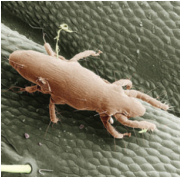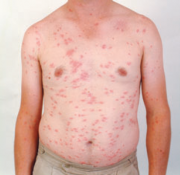Straw itch mites can be a problem when dried foodstuffs (fruits, seeds, cereal products and pet food) and especially baled hay, are infested with the larvae of storage insects and placed in warm, humid environments. Under these conditions large numbers develop. The mites are predators of insect larvae and also attack man and any domestic animal that comes into contact with infested material.
Biology of itch mites
Itch mites develop from an egg to a larva, nymph and adult. The life cycle usually takes two to four weeks but this depends on the mite species and the weather. Female mites can lay up to 200 to 300 eggs.
Itch mites are extremely small, normally only 0.2mm long, but a female engorged with eggs can reach 2mm.

Straw itch mites live on the larvae of several stored product pests such as the Angoumois grain moth, the saw-toothed grain beetle, the pea weevil and the cowpea weevil.
Symptoms of itch mite bites
After contact with infested produce, skin irritations may develop. These may be caused by an allergic response to the produce, but in many cases the small itchy welts or sores are a symptom of a condition commonly known as hay or chaff itch.

Mites bite the covered areas of the human body, especially the waist, under-arms and the inside leg, but do not bore into the skin like the scabies mite.
The bites cause an allergic reaction on the skin in most people, characterised by a red weal with a central blister. This is accompanied by a severe itching sensation. Rubbing or scratching of the affected area will burst the blister and promote secondary infections and other problems including dermatitis.
Straw itch mites do not breed on mammals, and if infested produce is avoided for several days, the condition will subside.
Treatment of itch mite bites
If you think you have been attacked by itch mites, remove the infested clothing and shower before putting on clean clothing.
When the welts appear, try not to scratch them. Seek medical advice, because the symptoms can be reduced, and prompt action will decrease the likelihood of skin infections or dermatitis.
In severe cases of mite attack, victims have reported headache, fever, nausea, vomiting, mild diarrhoea and joint pains. Do not feel embarrassed about seeking medical advice to cure the problem - itch mites have been biting humans long before we stopped using straw as a mattress filler.
Prevention and control of itch mites
The best way to avoid attack from itch mites is to prevent the mite population from developing in the first place. Keep stored food free of insects by either oven-drying, or by storing it at temperatures below 15°C to minimise the development of host larvae.
Small amounts of infested produce can be heated to 60°C in a oven and held at this temperature for one hour, or microwaved on a low setting for 5 minutes to kill the mites and their hosts. Larger quantities of infested produce will need to be fumigated in a chamber with methyl bromide or aluminium phosphide by a licensed operator. If the produce is heavily infested with stored product pests and itch mites, it may simpler to burn or dump the offending material.
When handling infested produce, apply a personal insect repellent to wrists, ankles, neck and waist before entering the infested area. The repellent should contain at least 50% of the active constituents as diethyltoluamide (DEET). This will greatly reduce the likelihood of receiving bites.

